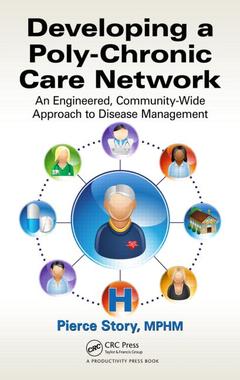Description
Developing a Poly-Chronic Care Network
An Engineered, Community-Wide Approach to Disease Management
Author: Story, MPHM Pierce
Language: English
Subjects for Developing a Poly-Chronic Care Network:
· 15.2x22.9 cm · Hardback
Description
/li>Contents
/li>Readership
/li>Biography
/li>
Although much has been achieved in care coordination and accountable care, healthcare leaders need additional, game-changing innovations to deal with constraints in clinical resources, care capacity, and cost that have not yet been fully addressed. This need for innovation is especially great in the care of the chronically ill: the most costly, highest-risk segments of our populations.
Filling this void, Developing a Poly-Chronic Care Network: An Engineered, Community-Wide Approach to Disease Management reconstructs and augments traditional chronic care delivery models. The proposed solution?the Poly-Chronic Care Network© (PCCN)?is a specific iteration of the Care Circle Network© (CCN) concept that creates a sustainable community-engaging response to the complexity, cost, and outcomes of chronic diseases. By dynamically engineering all the elements of a community?s "Capacity to Care" directly into short- and long-term patient care processes, the PCCN expands care capacity and physician "reach", and improves quality and outcomes, without increasing the total cost of care.
The book describes the fundamental concepts, principles, and requirements for the PCCN and explains how this care model could augment and enhance other new business models, such as Accountable Care Organizations (ACOs) and Patient-Centered Medical Homes (PCMHs). In addition to a detailed description of implementation steps and organizational structures, the text provides useful insights into technologies that can aid and enhance implementation, including home/virtual monitoring, social networking, and dynamic simulation. Importantly, the book includes both detailed examples and a flexible how-to guide for setting up a PCCN or other CCN, offering readers step-by-step guidelines and options for combining readily-available communal resources with simple technologies in the design of innovative care models for their communities.
With this book in hand, readers can confidently pick and choose specific components to match their community?s needs and capabilities, "amending the blend" to account for the size, scale, scope, and population of the community and patients they wish to serve.
Introduction. History of Healthcare Reform and the Current Buzzonym. Variability: The Killer of Capacity and the Maker of Outliers. Interdependencies. Simulation. DCAMM Principles and Concepts. PCDN Concept: the "What" and a Description. Build It and They May Not Come! Capacity as Strategy: The Rationale for the Concept. Understanding the Community: An Intro to Population Analysis and Prediction. Building a Network of Communal Resources. Resource Utilization Optimization. Processing Capability and Capacity. Space and Physical Infrastructure. Technology Infrastructure. Population Modeling and Predicting Resource Demand (and Capacity Requirements) (DCAMM Matching). A Word on Patient Responsibility: The Hardest Change to Make! Roadmaps and Potholes. Prologue: Outliers with the Outliers.
I believe that we can simultaneously impact quality, access, capacity, and cost when the right vision meets the necessary resources assisted by appropriate technologies.-Pierce Story, MPHM
Pierce Story is the co-Founder and Director of Concept Development for Capacity Strategies, Inc., a firm dedicated to the optimization of our nation’s total "Capacity to Care". His unique expertise lies in "Dynamic Care Capacity Management" (a concept he developed in 2007); process, systems, and resource utilization optimization; business/care model development; and the application of systems and process simulation.
During his 20+-year healthcare career, Pierce has developed innovative care and business models to improve health system operations and promote population health outcomes ("Care Circle Networks"). He has also worked in departmental and hospital-wide performance and capacity optimization as well as new facility construction planning throughout the care continuum, including work in Emergency Departments, Surgical Services, inpatient units, and community-based health clinics.
Pierce has written and lectured extensively on capacity and system optimization, advocating for dynamic, healthcare-specific analytical and improvement tools and methodologies that go beyond traditional industrial-based methodologies such as Lean. His most recent books, Developing a Poly-Chronic Care Network and Dynamic Capacity Management for Healthcare, detail innovative approaches to the optimization of the "Capacity to Care" throughout both hospitals and communities, and have received wide praise for their freshness. Other publications include numerous articles on simulation in healthcare, Dynamic Capacity Optimization, iterations of Care Circle Networks such as the "Poly-Chronic Care Network", and a co-edited book, Management Engineering for Effective Delivery.Prior to starting Capacity Strategies, Pierce worked both on




